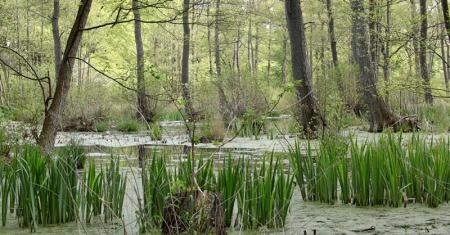
Area characterisation:
The majority of the Danish forest area is located on privately owned land with ownership distributed between nearly 25.000 private individuals, foundations and firms, oftening hold some of the most unique and interesting populations of endangered animal and plant species locally and the most forest biodiversity overall. There is an urgent need to bring these privately-owned forest areas into play as providers of safe biological corridors and microhabitats. Research shows that private forest owners are ready to participate in biodiversity creation and protection if given appropriate incentives.
Objective:
This case study from the SINCERE project had the goal to:
- Inspire changes to existing public grant schemes for biodiversity protection on privately owned land by demonstrating in practice how a competitive bidding process can improve the coordination of nature conservation efforts, cost-effectiveness, and ownership among landowners.
- Implement a reverse auction where forest owners respond to a fairly open call by offering biodiversity conservation measures that they decide themselves. In the offer, they describe the measure in terms of actions, imposed restrictions and the price they ask for implementing it.
Potential impacts/benefits:
The regulatory framework and the use of biological knowledge, biological context, permanence assessments, etc. suggests a net positive, and that additional impact will be achieved.
Given the regulatory context and the generally intensive management of Danish land, there is little reason to suspect on-property leakage.
Actions:
This case study tested the use of reverse auctions for allocating incentive payments through a bidding process, thus engaging forest owners in cost-effective provision of biodiversity protection on their lands.
The reverse auction was implemented as a discriminatory price auction where the landowners were asked to both design the action to be taken and to set the price, thus creating a positive incentive. Additional enabling measures included a detailed description of the information to provide in the bid, and access to research-based recommendations about different types of measures to include.
The reverse auction held information campaigns for forest owners during spring 2020, to reach relevant target groups. As a result, 24 different action bids were received amounting to more than € 180,000 – more than three times the available budget anticipated, thus ensuring competition.
For the best bids, contracts specified actions to be undertaken by the landowners and registered management restrictions. In all cases, the landowner had managed the contracted areas to provide relevant potential for biodiversity protection and the contracts implied further restrictions on management, in particular on future management options, suggesting that additional gains and quality of biodiversity protection will result from the actions.
The forest owners setting aside existing mature forest for biodiversity received compensation in the range 5-15,000 € per hectare for permanent revocation of production rights on the land under contract, while for actions involving more drastic measures, often on agricultural land, compensations were higher.
Transferability of result:
National geographical upscaling: The case study targeted a limited area and with limited funding, but interest from landowners suggests that there is, in principle, potential for upscaling to the entire country. A critical limitation for such upscaling is the amount of available funding, either from the Danish government or from private nature protection agents.
Upscaling to other schemes: There is potential for extrapolating the lessons learned to other biodiversity protection schemes, notably those with a high resemblance to the innovative mechanism (IM) here, for instance a scheme of setting forest aside for biodiversity.
Upscaling in scope: Reverse auction may be suitable for upscaling to other ES, such as reducing emission from carbon rich agricultural soils. This usually requires reduced management, perhaps increased inundation, and other site-specific actions. Potential funding for such actions in Denmark alone will be around several 100 million € over the coming years. In modified forms, the innovation mechanism may also be worthwhile in e.g. land use change actions related to reduced nitrogen loads and the Water Framework Directive.
Upscaling to other countries: This would require national regulations to permit other Innovation Mechanism designs. With increasing attention to biodiversity issues in the EUs regulatory framework, nation states could choose to allocate more of their share of funds. Forest ownership and regulatory frameworks vary considerably across countries and can limit the supply of relevant forest areas. If regulation already requires high levels of biodiversity protection on public and/or private land, options for additional gains are reduced. The greatest potential for upscaling may be in countries where two conditions are fulfilled: i) current regulations allow forest owners to decide on management, and ii) private forest owners own a non-trivial part of biologically valuable forestland.
Organisations:
NBS goals:
- Restoring ecosystems and their functions
Publications and reports:
Lundhede, T., Strange, N., Termansen, M., Jacobsen, J.B., Vedel, S.E. and Thorsen, B.J., Using Data Envelopment Analysis on Auction Data for Biodiversity Conservation. IFRO Reports, No. 284. University of Copenhagen, Department of Food and Resource Economics
horsen, BJ, Strange, N, Jacobsen, JB, Termansen, M & Lundhede, T. 2018. Auction mechanisms for setting aside forest for biodiversity. IFRO Report, no. 267, Department of Food and Resource Economics, University of Copenhagen, Frederiksberg.